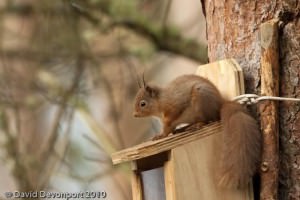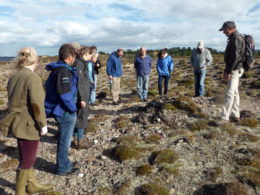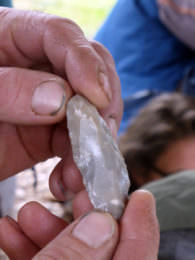Squirrel Survey. Last month’s group activity on the land involved a survey to record information about the presence of red squirrels in the Wilkie’s Wood. Scotland is a stronghold for the red squirrel, which is the only native squirrel in the UK with about 120,000 out of the estimated UK population of 140,000 being recorded. Our woods use to have a healthy population of squirrels until three years ago when no sightings were recorded for two years. This spring there were one or two sightings but nothing since then apart from some indications that they might be present by some finds of stripped cones.
Scotland is a stronghold for the red squirrel, which is the only native squirrel in the UK with about 120,000 out of the estimated UK population of 140,000 being recorded. Our woods use to have a healthy population of squirrels until three years ago when no sightings were recorded for two years. This spring there were one or two sightings but nothing since then apart from some indications that they might be present by some finds of stripped cones.
Our survey involved recording the location, number and age of gnawed cones found in the woods with nine people working in pairs to cover different areas. Time and numbers of people only allowed us to concentrate on areas suspected of having cones present which were the NW and NE compartments.
Results indicated a considerable number of cones in the NW compartment (443) with the highest concentration near the northern track in this part of the wood and only one hotspot in the NE compartment (60 out of 62) giving a total of 505. If we take the rough estimate of 20 cones a day as a squirrel’s average food requirement, that would give an estimate of a squirrel being present for 25 days in our woods (although of course there may have been more than one present for a lesser time.) More good news is that there are an increasing number of cones being eaten over time with 104 being recorded as old, 152 as medium and 249 as new.
 Unfortunately a depressing find was made a fortnight after this survey when a dead adult squirrel was found in one of the Bagend gardens in Pineridge. There were no clear indications that the animal had been caught by a cat or how it had died although photos were taken and have been sent to the Red Squirrels of the Highlands organisation for their thoughts about this. The level of decomposition indicated that the squirrel had been dead for less than a week. The story so far does however have a positive ending with two squirrels having been sighted in the NW compartment on the 16th of October by Duncan Easter – the first since the spring! We are hoping that in time a population of squirrels will return again to nest in our woods but in the meantime we would like you to help by reporting any sightings to our land manager at [email protected] Many thanks and wishing you happy squirrel watching in the future!
Unfortunately a depressing find was made a fortnight after this survey when a dead adult squirrel was found in one of the Bagend gardens in Pineridge. There were no clear indications that the animal had been caught by a cat or how it had died although photos were taken and have been sent to the Red Squirrels of the Highlands organisation for their thoughts about this. The level of decomposition indicated that the squirrel had been dead for less than a week. The story so far does however have a positive ending with two squirrels having been sighted in the NW compartment on the 16th of October by Duncan Easter – the first since the spring! We are hoping that in time a population of squirrels will return again to nest in our woods but in the meantime we would like you to help by reporting any sightings to our land manager at [email protected] Many thanks and wishing you happy squirrel watching in the future!
Archaeology and Wildlife Walks and Talks. Michael Sharpe’s walk and talk about the archaeology of the area was well attended with fourteen people initially gathering under the woodland shelter to view some of the artefacts he has found over the past ten years whilst investigating the area. These included scrapers, parts of funerary urns, human bone fragments, flint chippings and necklace beads from the Bronze Age. The group then walked out to an important site near the sea on the way locating cracked cooking stones that had been used thousands of years ago and hearing from Michael about how the landscape had been formed, had changed and where archaeological finds are most likely to be found.At the site people became aware of the far greater concentration of artefacts in the
fourteen people initially gathering under the woodland shelter to view some of the artefacts he has found over the past ten years whilst investigating the area. These included scrapers, parts of funerary urns, human bone fragments, flint chippings and necklace beads from the Bronze Age. The group then walked out to an important site near the sea on the way locating cracked cooking stones that had been used thousands of years ago and hearing from Michael about how the landscape had been formed, had changed and where archaeological finds are most likely to be found.At the site people became aware of the far greater concentration of artefacts in the  area including an obvious shell midden where our ancestors had discarded shellfish shells after collecting and eating them. They were also aware that over the next few decades the whole area would no doubt have been completely eroded by the encroaching sea. The group then proceeded to a nearby area where there was a burnt mound – a large collection of cracked heating stones that had been left piled up. After a short question and answer session, Michael was thanked and people disbanded, all with a greater sense of connection with their local past.
area including an obvious shell midden where our ancestors had discarded shellfish shells after collecting and eating them. They were also aware that over the next few decades the whole area would no doubt have been completely eroded by the encroaching sea. The group then proceeded to a nearby area where there was a burnt mound – a large collection of cracked heating stones that had been left piled up. After a short question and answer session, Michael was thanked and people disbanded, all with a greater sense of connection with their local past.
It was disappointing that only two people attended Dan Puplett’s wildlife walk on the 11th September as it gave an excellent insight into the creatures living parallel and fascinating lives next to us humans who generally are totally unaware of even their presence. A highlight was seeing the regular snuffle holes made by badger in the grassland area near the wind turbines. Others were seeing evidence of fox, uncovering a devil’s coachman beetle, getting to examine a Southern Hawker Dragonfly up close and watching a flock of Longtail Tits and other bird species flit through the bushes. The feedback has been that people would like both these events to be repeated to allow those unable to come to have the opportunity to attend – we will see what we can do for next year.
Integrated Management Plan Progress. Funding has been sought for a consultant to take on putting together this important document – an action plan giving details on the FHT’s development priorities, timescales and funding possibilities for the next five years that will be developed from the Public Consultation report, Local Biodiversity Action Plan and other documents. However it has become clear that to progress this more quickly and to be able to freely select the consultant of our choice, the FHT will have to fund this itself. The trust is looking to take on Chris Piper a local consultant that put together the very successful and useful previous plan for the Findhorn Hinterland Group in 2009. He has good background knowledge of the area, a good track record in this field, could start immediately and is willing to do the plan for a very reasonable fee. More information will be provided about this next month once details have been sorted out.

















October 2016 News
Squirrel Survey. Last month’s group activity on the land involved a survey to record information about the presence of red squirrels in the Wilkie’s Wood. Scotland is a stronghold for the red squirrel, which is the only native squirrel in the UK with about 120,000 out of the estimated UK population of 140,000 being recorded. Our woods use to have a healthy population of squirrels until three years ago when no sightings were recorded for two years. This spring there were one or two sightings but nothing since then apart from some indications that they might be present by some finds of stripped cones.
Scotland is a stronghold for the red squirrel, which is the only native squirrel in the UK with about 120,000 out of the estimated UK population of 140,000 being recorded. Our woods use to have a healthy population of squirrels until three years ago when no sightings were recorded for two years. This spring there were one or two sightings but nothing since then apart from some indications that they might be present by some finds of stripped cones.
Our survey involved recording the location, number and age of gnawed cones found in the woods with nine people working in pairs to cover different areas. Time and numbers of people only allowed us to concentrate on areas suspected of having cones present which were the NW and NE compartments.
Results indicated a considerable number of cones in the NW compartment (443) with the highest concentration near the northern track in this part of the wood and only one hotspot in the NE compartment (60 out of 62) giving a total of 505. If we take the rough estimate of 20 cones a day as a squirrel’s average food requirement, that would give an estimate of a squirrel being present for 25 days in our woods (although of course there may have been more than one present for a lesser time.) More good news is that there are an increasing number of cones being eaten over time with 104 being recorded as old, 152 as medium and 249 as new.
Archaeology and Wildlife Walks and Talks. Michael Sharpe’s walk and talk about the archaeology of the area was well attended with fourteen people initially gathering under the woodland shelter to view some of the artefacts he has found over the past ten years whilst investigating the area. These included scrapers, parts of funerary urns, human bone fragments, flint chippings and necklace beads from the Bronze Age. The group then walked out to an important site near the sea on the way locating cracked cooking stones that had been used thousands of years ago and hearing from Michael about how the landscape had been formed, had changed and where archaeological finds are most likely to be found.At the site people became aware of the far greater concentration of artefacts in the
fourteen people initially gathering under the woodland shelter to view some of the artefacts he has found over the past ten years whilst investigating the area. These included scrapers, parts of funerary urns, human bone fragments, flint chippings and necklace beads from the Bronze Age. The group then walked out to an important site near the sea on the way locating cracked cooking stones that had been used thousands of years ago and hearing from Michael about how the landscape had been formed, had changed and where archaeological finds are most likely to be found.At the site people became aware of the far greater concentration of artefacts in the  area including an obvious shell midden where our ancestors had discarded shellfish shells after collecting and eating them. They were also aware that over the next few decades the whole area would no doubt have been completely eroded by the encroaching sea. The group then proceeded to a nearby area where there was a burnt mound – a large collection of cracked heating stones that had been left piled up. After a short question and answer session, Michael was thanked and people disbanded, all with a greater sense of connection with their local past.
area including an obvious shell midden where our ancestors had discarded shellfish shells after collecting and eating them. They were also aware that over the next few decades the whole area would no doubt have been completely eroded by the encroaching sea. The group then proceeded to a nearby area where there was a burnt mound – a large collection of cracked heating stones that had been left piled up. After a short question and answer session, Michael was thanked and people disbanded, all with a greater sense of connection with their local past.
It was disappointing that only two people attended Dan Puplett’s wildlife walk on the 11th September as it gave an excellent insight into the creatures living parallel and fascinating lives next to us humans who generally are totally unaware of even their presence. A highlight was seeing the regular snuffle holes made by badger in the grassland area near the wind turbines. Others were seeing evidence of fox, uncovering a devil’s coachman beetle, getting to examine a Southern Hawker Dragonfly up close and watching a flock of Longtail Tits and other bird species flit through the bushes. The feedback has been that people would like both these events to be repeated to allow those unable to come to have the opportunity to attend – we will see what we can do for next year.
Integrated Management Plan Progress. Funding has been sought for a consultant to take on putting together this important document – an action plan giving details on the FHT’s development priorities, timescales and funding possibilities for the next five years that will be developed from the Public Consultation report, Local Biodiversity Action Plan and other documents. However it has become clear that to progress this more quickly and to be able to freely select the consultant of our choice, the FHT will have to fund this itself. The trust is looking to take on Chris Piper a local consultant that put together the very successful and useful previous plan for the Findhorn Hinterland Group in 2009. He has good background knowledge of the area, a good track record in this field, could start immediately and is willing to do the plan for a very reasonable fee. More information will be provided about this next month once details have been sorted out.